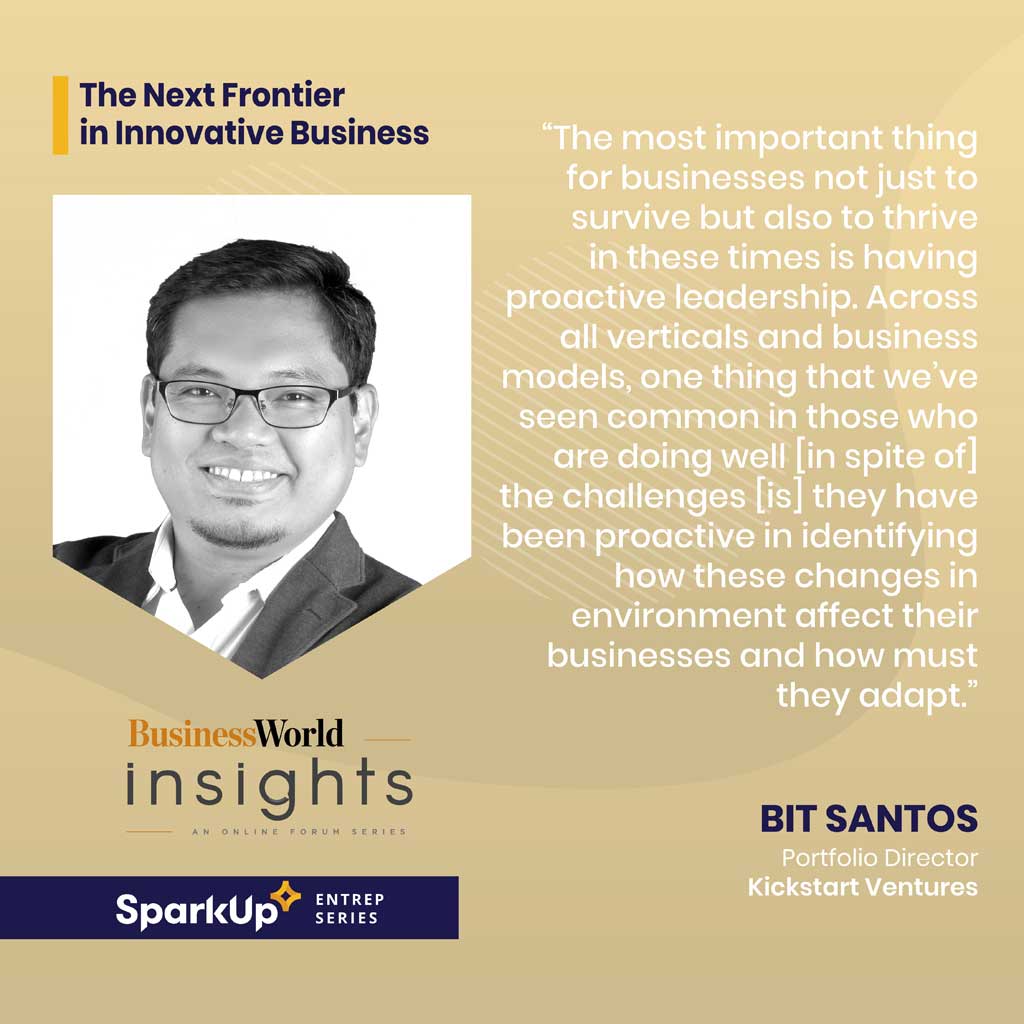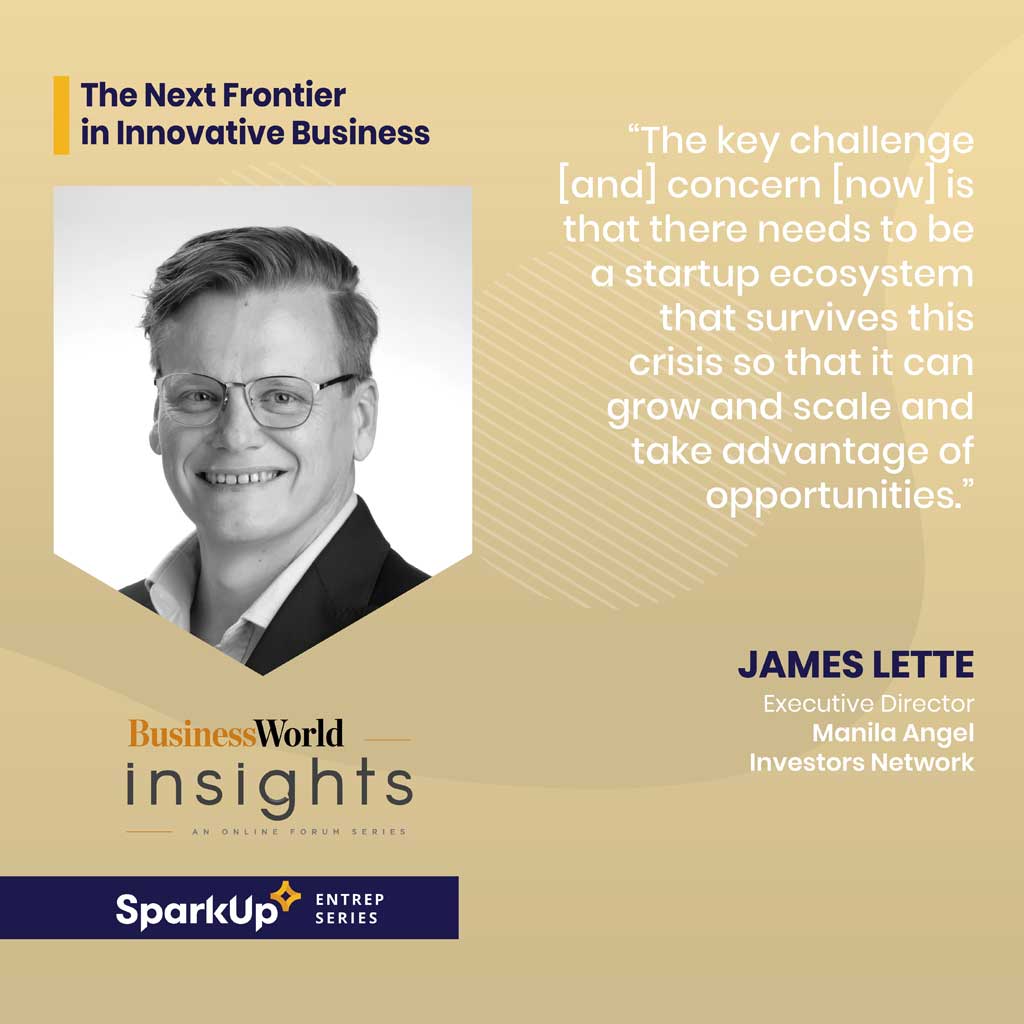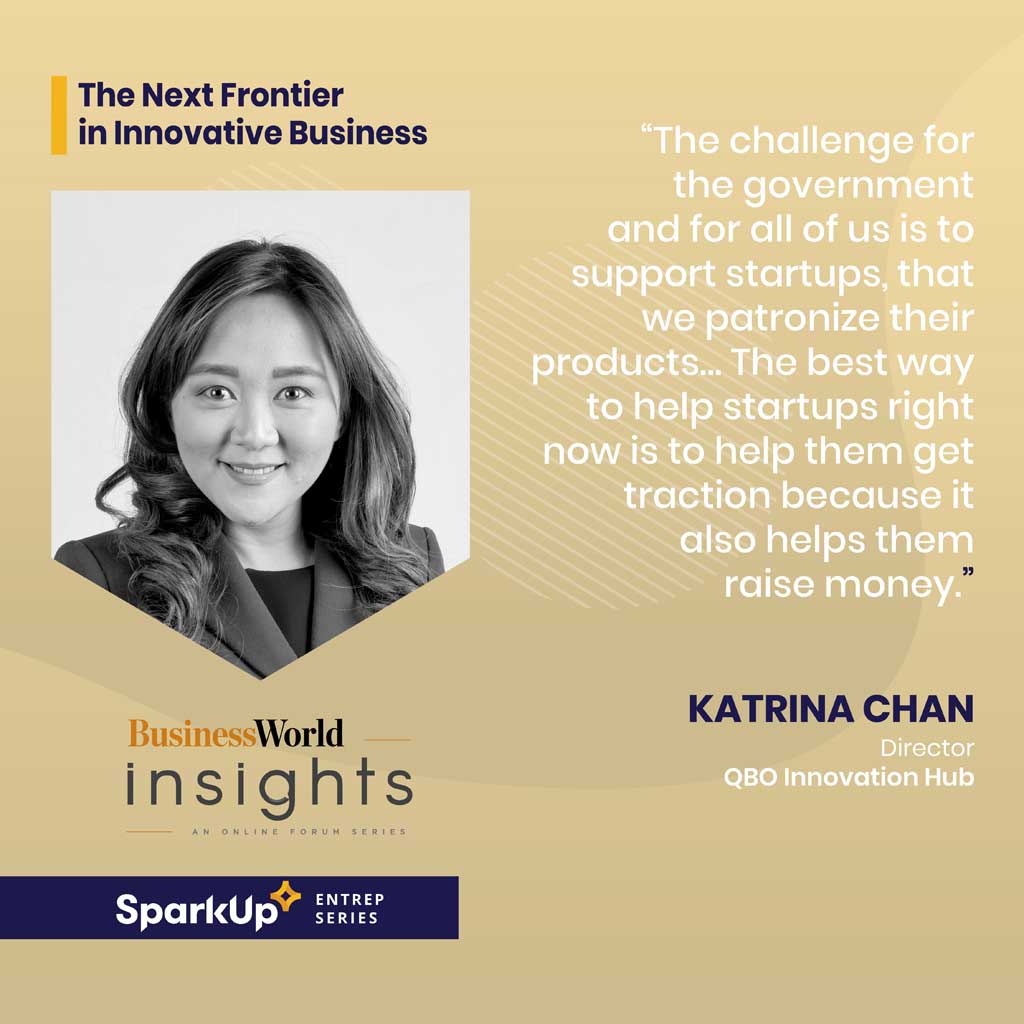2nd leg of BusinessWorld Insights SparkUp Entrep Series highlights value of innovation as economy moves forward
The coronavirus disease 2019 (COVID-19) pandemic has pushed the startup community to pivot into serving the immediate needs of consumers as well as to reinvent themselves. As the economy slowly reopens, startups and businesses in general look should not only take the opportunities to bounce back but also go further towards innovation, as the panel in the second leg of BusinessWorld Insights SparkUp Entrep Series shared.
Moderated by Carlo Calimon, director of StartUp Village, the online forum held last June 30 gathered insights and personal experiences during the pandemic from thought leaders from corporate, investing, and startup fields.
Empowering MSMEs
 Mitch Locsin, first vice president and sales head of PLDT Enterprise, noted the shifts micro, small, and medium enterprises (MSMEs) did amid the heavy impact brought by the pandemic.
Mitch Locsin, first vice president and sales head of PLDT Enterprise, noted the shifts micro, small, and medium enterprises (MSMEs) did amid the heavy impact brought by the pandemic.
“From a brighter perspective, the global pandemic has made us realize how flexible and agile we can be in terms of doing business. Many MSMEs have found ways to reinvent themselves during the pandemic, by adopting new business models or shifting their platforms to online and digital,” Mr. Locsin added.
MSMEs are also shifting to e-commerce platforms and are adopting contactless payment systems since the past few months of the crisis, he added.
Out of working closely with customers from various sectors, the company’s core functional teams (CFTs) found out that a strong and reliable connectivity solution is indeed the foundation of digital transformation; yet the solutions must go beyond connectivity and so must be relevant and budget-friendly for MSMEs.
Aside from noting activity in the MSME sector, Mr. Locsin also observed a spur in the startup industry, with many of them finding new solutions in the new normal. He cited as an example the Project Green Grass, an Internet of Things-enabled end-to-end smart city solution which provides a free online community map of real-time screen activity using closed-circuit television (CCTV) networks.
“It allows the community or the LGU to have a view of the crowded city, whether it’s per barangay or in a certain area. This really helps LGUs manage their operations in their respective locations efficiently,” he added.
Mr. Locsin also noted the uptrend in telemedicine applications, saying that their company started working with startup companies in assessing the apps, which basically include appointment setting, video conferencing, e-prescriptions, and e-payment features.
Surviving and thriving
 The biggest challenge for innovative startups and entrepreneurs today is making sure their businesses revive, Bit Santos, portfolio director at corporate venture capital firm Kickstart Ventures, pointed out.
The biggest challenge for innovative startups and entrepreneurs today is making sure their businesses revive, Bit Santos, portfolio director at corporate venture capital firm Kickstart Ventures, pointed out.
Among the many things the crisis has turned around, the most critical change he noted is concerning the goals of startups. “Whereas previously, the purpose of a startup is really to grow rapidly. In these times, it’s not a time for growth but it is a time for survival,” he said. “We simply need to survive while the world is changing and put ourselves into a position to get back on track.”
Moreover, Mr. Santos said that for businesses to survive and thrive, proactive leadership is very important.
“Across all verticals and business models, that is one thing that we’ve seen common in startups who are doing well, given the challenges,” he stressed. “They have been proactive in identifying how these changes in environment affect their businesses and how must they adapt.”
He also advises young founders and entrepreneurs, who apparently encounter their first economic downturn, to lean on their advisers, investors, and mentors who may have experiences that will complement theirs.
Mr. Santos also has this to say for founders who are much stressed over the current situation and feel accountable for their business and for their people: “If you need time to take care of yourself first, take the time that you need to step back and take care of yourself, so that you can make sure that you can take care of your people, your business, and your customers.”
The portfolio director also noted that as the firm has recently seen many pitches from entrepreneurs and founders, they are looking for those that intend to solve these problems in a sustainable and scalable manner.
“I think it’s a good sign that we’re seeing all of these entrepreneurs identifying these opportunities. But it’s also just as important that the demand for these kinds of solutions is also there,” he said.
‘Prime time’ for startups
 Sharing his numerous experiences as he joined the startup community in shifting gears and helping the government during the pandemic, Winston Damarillo, chief executive officer of Talino Venture Labs and executive chairman of Amihan Global Strategies, finds that it is “the best time to be a startup all over again”.
Sharing his numerous experiences as he joined the startup community in shifting gears and helping the government during the pandemic, Winston Damarillo, chief executive officer of Talino Venture Labs and executive chairman of Amihan Global Strategies, finds that it is “the best time to be a startup all over again”.
Talino Venture Labs, he shared, pivoted three existing ventures it built. Saffron, an insurance company focused primarily on providing cyberinsurance, pivoted to health and business insurance while leveraging its insuretech products. Asenso, an end-to-end MSME business accelerator, moved to provide small business loans. Unawa, meanwhile, moved from building startups to facilitate digital transactions.
The firm also built three new startups, Mr. Damarillo added. These are: a platform that addresses contact tracing, another that will take advantage of contactless and cashless payments in restaurants, and an MSME bank.
In addition, IT developer organization Devcon—which Mr. Damarillo founded and current heads—was able to raise about 1,000 developer volunteers that helped the government create a digital infrastructure for pandemic response in the country.
Moreover, Devcon was able to provide the Inter-Agency Task Force on Emerging Infectious Diseases a solution that will help with quarantine management—a nationally-deployable product that can handle about a million QR code passes in 180 checkpoints. Following this is ReliefAgad, designed to streamline speed up the distribution of financial aid in the country.
“We played offense instead of defense, and I think every startup should have that mindset,” he added.
Moreover, Mr. Damarillo underscored the importance of government in rebooting startups.
“I think we have seen in the pandemic that there’s a lot more infrastructure that the government needs… I think there’s a lot of what I would call digital ‘Build, Build, Build’. That’s a great opportunity to work with the government, and the government has been really open to doing that now with startups,” he said.
Solutions during pandemic
 Eunice Braga, external relations manager of IdeaSpace, finds that there are huge opportunities for startups to take as the pandemic is expected to accelerate digital transformation in the Philippines.
Eunice Braga, external relations manager of IdeaSpace, finds that there are huge opportunities for startups to take as the pandemic is expected to accelerate digital transformation in the Philippines.
“I think it will also power greater corporate startup engagement,” she added, “and we’re also going to see even more activity in terms of the creation, adoption, and mainstreaming of govtech products and services.
She also finds that there is an opportunity in creating or developing solutions to address new essentials, such as on-demand cleaning services, small-scale farming, urban gardening, digital insurance, and digital experiences, among others.
Regarding solutions that startups can offer at present, Ms. Braga observed that there are a couple of startups that are likely ahead of the digital transformation, citing as examples tax filing platform Taxumo and education solution FrontLearners.
“[FrontLearners have] managed to create a solution that is both online and offline, which I think will be critical as both public and private schools use blended learning platforms,” she shared. “And they have battle-tested it as well. They’ve piloted their solution in community schools post-typhoon and post-Marawi siege. They’re one of the startups which are definitely prepared for this moment.”
She also noted hyperlocal service Pandalivery, whose agility has been observed during the pandemic. “I remember seeing in the first two weeks of the quarantine that they jumped right on the opportunity to work with tricycle drivers that may have been misplaced because of the pandemic and bring them on board as delivery support,” she shared.
Looking for opportunities
 For James Lette, executive director of the Manila Angel Investors Network, while there are significant challenges, the opportunities during the current situation are massive and manifold if one can look for them and take advantage of them.
For James Lette, executive director of the Manila Angel Investors Network, while there are significant challenges, the opportunities during the current situation are massive and manifold if one can look for them and take advantage of them.
The opportunities also depend on what industry the company falls into, Mr. Lette added. “We know that some industries are thriving; we know that many are challenging. This could be a time when the unicorns (a tech startup company that reaches a $1 billion market value) of tomorrow are being founded, and I’m looking forward to finding out if that happens,” he said.
With such opportunities, however, a challenge remains. “The key challenge [and] concern is that there needs to be a startup ecosystem that survives this crisis, so that it can grow and scale and take advantage of these opportunities,” Mr. Lette pointed out.
With the budding of new ideas at present, Mr. Lette also pointed out how implementing an idea is as much important as the idea itself. “For instance, we’re a big backer of edutech, and a quarter of our portfolio is there… [U]nfortunately, the implementation of online learning for some students has antagonized a lot of parents globally. So there’ll be some pushback against online learning once we get to the new normal,” he finds.
As he looks forward to meeting new startups in the near future, he intends to invest in those that have a strong argument as to how they will adapt through COVID-19 and how their product market fits in what will be the new normal.
“There’s going to be some ideas and some innovations out there that are going to change our lives, and I’m looking forward to seeing how they can come about,” he added. “The Manila Angel Investors Network [is here] to find them and support people [in achieving] their dreams.”
Need to support startups
 The startup community is facing a big reset, Katrina Chan, director of QBO Innovation Hub, noted. Nevertheless, this reset creates an opportunity for them to build and create solutions that will approach reopening their businesses as well as thriving and potentially growing post-pandemic.
The startup community is facing a big reset, Katrina Chan, director of QBO Innovation Hub, noted. Nevertheless, this reset creates an opportunity for them to build and create solutions that will approach reopening their businesses as well as thriving and potentially growing post-pandemic.
These circumstances have also seen some shifts in potential business partners and investors, Ms. Chan added. “I think businesses are more potentially open-minded right now to be willing to set aside some of their old practices and embrace new norms,” she said.
Ms. Chan also finds that there are startups that have taken the opportunity to deal with the immediate impacts of the pandemic as well as the opportunity to rebuild their businesses and inspire confidence as they reopen. She observed as well startups taking advantage of trends that arose from the lockdown, like e-commerce and remote services.
Citing a recent PricewaterhouseCoopers (PwC) survey on startups, where QBO collaborated, Ms. Chan noted that 21% of startups experienced an upsized surge in demand for their services and products and so face a whole set of challenges in terms of how will meet such demand, while the remaining felt that their demand dropped overnight.
“For that group, the challenge is now how do we pivot or retool ourselves and how do we think of solutions that can stick, not just to adapt to what’s going on for today, but how [should it] be sustained in the future,” she added.
Not only do startups face challenges, but a challenge is also set for the government and the public. For Ms. Chan, that is to support startups and patronize their products.
“The best way to help startups right now is to help them get traction [as this] helps them raise money,” she said.

 Mitch Locsin, first vice president and sales head of PLDT Enterprise, noted the shifts micro, small, and medium enterprises (MSMEs) did amid the heavy impact brought by the pandemic.
Mitch Locsin, first vice president and sales head of PLDT Enterprise, noted the shifts micro, small, and medium enterprises (MSMEs) did amid the heavy impact brought by the pandemic. The biggest challenge for innovative startups and entrepreneurs today is making sure their businesses revive, Bit Santos, portfolio director at corporate venture capital firm Kickstart Ventures, pointed out.
The biggest challenge for innovative startups and entrepreneurs today is making sure their businesses revive, Bit Santos, portfolio director at corporate venture capital firm Kickstart Ventures, pointed out. Sharing his numerous experiences as he joined the startup community in shifting gears and helping the government during the pandemic, Winston Damarillo, chief executive officer of Talino Venture Labs and executive chairman of Amihan Global Strategies, finds that it is “the best time to be a startup all over again”.
Sharing his numerous experiences as he joined the startup community in shifting gears and helping the government during the pandemic, Winston Damarillo, chief executive officer of Talino Venture Labs and executive chairman of Amihan Global Strategies, finds that it is “the best time to be a startup all over again”. Eunice Braga, external relations manager of IdeaSpace, finds that there are huge opportunities for startups to take as the pandemic is expected to accelerate digital transformation in the Philippines.
Eunice Braga, external relations manager of IdeaSpace, finds that there are huge opportunities for startups to take as the pandemic is expected to accelerate digital transformation in the Philippines. For James Lette, executive director of the Manila Angel Investors Network, while there are significant challenges, the opportunities during the current situation are massive and manifold if one can look for them and take advantage of them.
For James Lette, executive director of the Manila Angel Investors Network, while there are significant challenges, the opportunities during the current situation are massive and manifold if one can look for them and take advantage of them. The startup community is facing a big reset, Katrina Chan, director of QBO Innovation Hub, noted. Nevertheless, this reset creates an opportunity for them to build and create solutions that will approach reopening their businesses as well as thriving and potentially growing post-pandemic.
The startup community is facing a big reset, Katrina Chan, director of QBO Innovation Hub, noted. Nevertheless, this reset creates an opportunity for them to build and create solutions that will approach reopening their businesses as well as thriving and potentially growing post-pandemic.
